Now Unpaywalled: Ashoka the Great Was, In Fact, Pretty Great
And his legacy is more important than ever as India becomes a great power
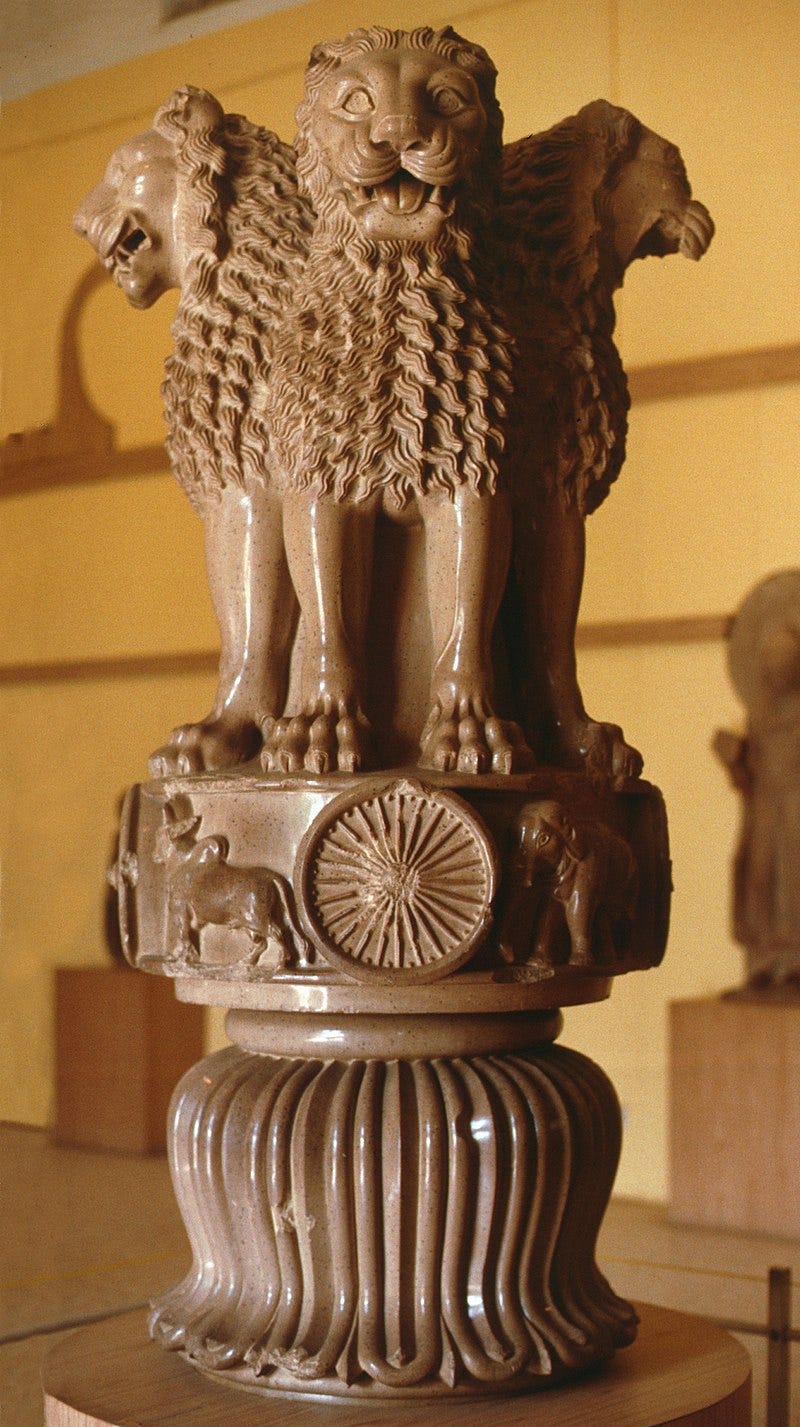
Living in an age of extraordinary technological and socioeconomic advances, it’s easy to construct a mental model of history as a teleological “Whig” progression from better to worse, with the past few millennia as mere “Dark Age” forerunners of Modernity, the surge of incredible global progress in literacy, health, and prosperity in the two centuries since the Industrial Revolution. There’s a lot of truth to this: we are in a period of unprecedented global prosperity! It’s all too easy to mentally round off empires and wars from Assyria through the Ashanti as a mere parade of slavery, conquest, and senseless bloodshed: “Those Ancient Guys Who Sucked.” That’s a gross oversimplification, of course, eliding centuries of complexity, but there is a grain of truth to it. Most historic rulers and monarchs are indeed terrible people from today’s point of view: rare is the premodern potentate who did not regularly enslave, conquer, and order actions that would now be considered war crimes.
However, there is one particularly notable exception. As H.G. Wells once wrote “Amidst the tens of thousands of names of monarchs that crowd the columns of history, their majesties and graciousnesses and serenities and royal highnesses and the like, the name of Ashoka shines, and shines, almost alone, a star.”
Note to readers: if you’re from India, this article may seem to discuss common knowledge to the point of banality, akin to an American reading an article on how Abraham Lincoln is generally considered a morally upright guy. But this writer has found that the history of Ashoka and the Maurya Empire remains surprisingly little-known in North America and Europe, so it’s worth discussing!
Full article now unpaywalled!
Ashoka (also written as Asoka or Aśoka) took the throne of the Maurya Empire1, covering much of northern India, sometime around 269 or 268 BCE, ruling from the Mauryan capital city of Pataliputra until about 232 BCE. For the first eight years of his reign, he was a standard premodern ruler, conquering neighboring states to expand his empire. Some stories even describe him (questionably) as particularly cruel and sadistic during this period. Then, around 260 BCE, he converted to the then-still-new religion of Buddhism after victory in the bloody Kalinga War, and underwent an extraordinary change. In the Edicts of Ashoka, written on pillars, stones, and cave walls2, he expounded his new governing philosophy. The publicness of these announcements was fairly progressive in itself (Ashoka lived only about 1,500 years after the 1750s BCE Code of Hammurabi, the first law code to be written down and shown to the public as opposed to consisting of “whatever the ruler feels like right now”). They may have been intended to be regularly read out by community leaders to the (presumably majority-illiterate) Maurya population as a sort of combined religious instruction, code of conduct, and national credo, arguably akin to the Pledge of Allegiance in modern American schools.
Most of what we know about Ashoka’s life and reign is a tangle of myths and legends from multiple parts of the Indian subcontinent, often containing implausible supernatural elements, combined with extrapolations from archaeological evidence that are inherently open to interpretation3. As a surviving primary source, the Ashokan Edicts constitute our best historical record for the period, as well as chronicling a truly extraordinary moment in ethical and governing philosophy.
The Edicts of Ashoka
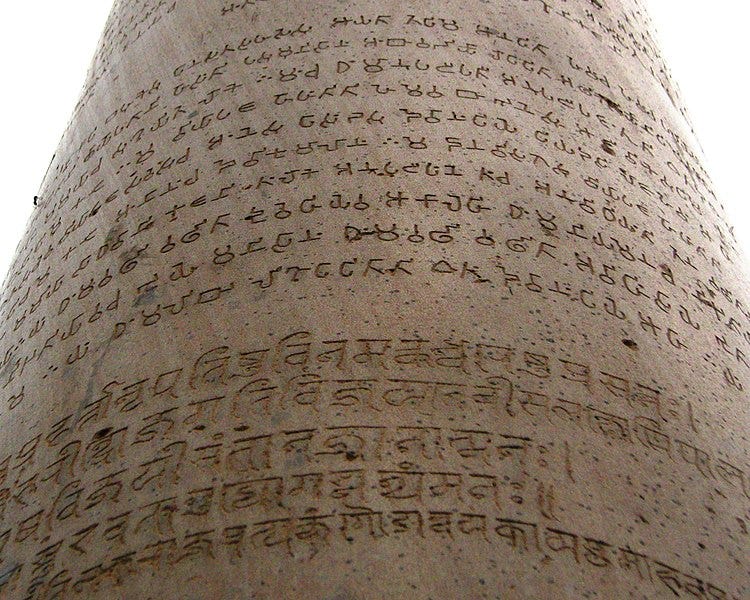
Selected text from the Major Rock Edicts, below, from World History Encyclopedia, a UNESCO-affiliated NGO and a source recommended by European Commission educational initiatives.
“Piyadasi” is a title meaning something like “He who regards others with kindness.” It’s thought to be another name used by Ashoka, but it’s just possible that it was a separate king, perhaps earlier in the dynasty, in which case this entire article should be talking about “Piyadasi the Great” not “Ashoka the Great.”
“Dhamma” is another spelling of “Dharma,” a difficult-to-translate concept (sometimes glossed as “virtue” or “cosmic order”) common to many Indian religions.
Edict I
“Here (in my domain) no living beings are to be slaughtered or offered in sacrifice…Formerly, in the kitchen of Beloved-of-the-Gods, King Piyadasi, hundreds of thousands of animals were killed every day to make curry. But now with the writing of the Dhamma edict, only three creatures, two peacocks and a deer, are killed, and the deer not always. And in time, not even these creatures will be killed.”
Edict II
“Everywhere has Beloved-of-the-Gods, King Piyadasi, made provision for two types of medical treatment: medical treatment for humans and medical treatment for animals. Wherever medical herbs suitable for humans or animals are not available, I have had them imported and grown. Wherever medical roots or fruits are not available I have had them imported and grown. Along roads I have had wells dug and trees planted for the benefit of humans and animals.”
Edict V
“Beloved-of-the-Gods, King Piyadasi, speaks thus: To do good is difficult. One who does good first does something hard to do. I have done many good deeds, and, if my sons, grandsons, and their descendants up to the end of the world act in like manner, they too will do much good. But whoever amongst them neglects this, they will do evil. Truly, it is easy to do evil.”
Edict VI
“Beloved-of-the-Gods, King Piyadasi, speaks thus: In the past, state business was not transacted nor were reports delivered to the king at all hours. But now I have given this order, that at any time, whether I am eating, in the women's quarters, the bed chamber, the chariot, the Palanquin, in the park, or wheresoever, reporters are to be posted with instructions to report to me the affairs of the people so that I might attend to these affairs wherever I am.”
Edict VII
“Beloved-of-the-Gods, King Piyadasi, desires that all religions should reside everywhere, for all of them desire self-control and purity of heart. But people have various desires and various passions, and they may practice all of what they should or only a part of it. But one who receives great gifts yet is lacking in self-control, purity of heart, gratitude and firm devotion, such a person is mean.”
Edict VIII
“In the past, kings used to go out on pleasure tours during which there was hunting and other entertainment. But ten years after Beloved-of-the-Gods had been coronated, he went on a tour to Sambodhi [site of Buddha's enlightenment] and thus instituted Dhamma tours. During these tours, the following things took place: visits and gifts to Brahmans and ascetics, visits and gifts of gold to the aged, visits to people in the countryside, instructing them in Dhamma, and discussing Dhamma with them as is suitable. It is this that delights Beloved-of-the-Gods, King Piyadasi, and is, as it were, another type of revenue.”
Edict XII
“Whoever praises his own religion, due to excessive devotion, and condemns others with the thought 'Let me glorify my own religion', only harms his own religion…One should listen to and respect the doctrines professed by others.”
Edict XIII
“Beloved-of-the-Gods, King Piyadasi, conquered the Kalingas eight years after his coronation. One hundred and fifty thousand were deported, one hundred thousand were killed and many more died. After the Kalingas had been conquered, Beloved-of-the-Gods came to feel a strong inclination towards the Dhamma, a love for the Dhamma and for instruction in Dhamma. Now Beloved-of-the-Gods feels deep remorse for having conquered the Kalingas…Now it is conquest by Dhamma that Beloved-of-the-gods considers to be the best conquest…I have had this Dhamma edict written so that my sons and great-grandsons may not consider making new conquests, or that if military conquests are made, that they be done with forbearance and light punishment, or better still, that they consider making conquest by Dhamma only, for that bears fruit in this world and the next.”
The World of Ashoka
This counts as pretty liberal today, in the 21st century: vegetarianism, kindness to animals, healthcare, tree-planting, religious pluralism, nonviolence, and remorse for war crimes. For the 200s BCE, this is insanely ahead of its time. Readers may well be wondering “How do we know that Ashoka really did all these great things? Maybe this is just propaganda.” But that’s missing the point. The undeniably amazing part here is that at the very least, these inscriptions show that Ashoka wanted to be seen as a peaceful, religiously tolerant, tree-planting, well-digging, animal-loving ruler. That is wildly unprecedented for the time in which he lived. We’re looking at this with a 21st-century mindset and thinking “of course national leaders want to brag about how they’re enlightened and kind to animals and religiously tolerant and care about human rights, why should we trust them?” But Ashoka lived in the 200s BCE, when no other world leader was boasting of their kindness or expressing a concept anything like “human rights.” To the best of this writer’s amateur history buff-level knowledge, no other ruler had ever publicly expressed remorse for having conquered a territory before Ashoka’s edicts. Conquest was what rulers were supposed to do in Iron Age ethical systems!
The Duke of Qin, later Qin Shi Huang, was born during Ashoka’s reign and would bloodily conquer the neighboring kingdoms to become the first emperor of a unified China in 221 BCE. In 213 BCE, he ordered the burning of most existing books. When he died in 210 BCE, he was buried in the famous Terracotta Army-equipped mausoleum and had the workmen killed to preserve its secrets. In 146 BCE, less than a hundred years after Ashoka’s reign, Rome would destroy the rival city of Carthage, kill most of its inhabitants, loot the temples, and sell 50,000 survivors into slavery. This kind of thing was the baseline, what rulers were expected to do. Even when there were kings who chose to support scholarship and the arts (for example Hiero II of Syracuse, employer of Archimedes, and Ptolemy II Philadelphus of Egypt, funder of the Library of Alexandria, both of whom were contemporaries of Ashoka4) they were also expected to uncompromisingly fight to expand their kingdom and crush political rivals. Ptolemy II invaded Nubia and fought wars with Macedonia and the Seleucid Empire. Ancient monuments across civilizations are replete with descriptions glorying rulers’ victories and chronicling the enemy cities sacked and slaves taken, from Ramesses II’s sculptures of the Battle of Kadesh at Abu Simbel to the monument of victory in the Dacian Wars at Trajan’s Column.
And in the middle of all this comes Ashoka, talking about how he “feels deep remorse for having conquered the Kalingas” and “I have had this Dhamma edict written so that my sons and great-grandsons may not consider making new conquests” and “Along roads I have had wells dug and trees planted for the benefit of humans and animals.” That’s pretty amazing! We don’t know the exact circumstances of this ethico-religious transformation, but it kind of looks like Ashoka, and/or some unknown group of thinkers around him, managed to develop existing religions and philosophies of government into something close to modern cosmopolitan liberal humanism. We may never truly know how much daily life and administration in the Maurya Empire attempted to live up to this extraordinary flowering of ideals of peace, compassion, and civilization, but we know that Ashoka was trying to make it happen.
The Legacy of Ashoka
Ashoka may be little-known in the West, but he remains a key political and cultural icon in his homeland of India, akin to Augustus Caesar in Europe or Qin Shi Huang in China. The modern flag of India bears the Ashoka Chakra “wheel of dharma” symbol in its center (the same symbol as the one on the Lion Capital), the Ashoka Chakra medal is India’s highest military decoration for valor in peacetime, and many Indian films and TV shows dramatize his life.
And this is important cultural background information, because India is more prosperous, powerful, and influential now than ever before, and getting more prosperous, more powerful, and more influential by the year. Consider:
As of 2023, India is now the world’s most populous country with over 1.4 billion people, overtaking China5, which is now experiencing population decline.
The last few decades have seen incredible leaps in Indians’ quality of life. Extreme poverty has been reduced immensely, with the number of Indians living on (inflation-adjusted) $2.15 a day or less falling from over 420 million people in 1983 to under 140 million in 2019, even while the overall Indian population grew from under 750 million to over 1.3 billion in the same period!
In 1994, about 50% of Indians had access to at least basic electricity (i.e. a lightbulb and basic phone charger, but no appliances), rising to 99% in 2020.
43% of Indians used the Internet in 2020, up from 7.5% in 2010. And as many Indians are English-speaking and India’s internet isn’t firewalled off like China’s, this translates to substantial global influence on a person-to-person level.
And famously, in 2000 over 79% of Indians lacked access to improved sanitation facilities (i.e. they had no latrines or toilets and had to poop outside), falling to under 17% in 2020. That’s a huge increase in human well-being!
India is in the middle of accelerating, exponential renewables growth: their total installed solar capacity rose from 6 gigawatts in 2015 to 63 gigawatts in 2022.
And in India as across the world, renewable energy is dominating the future of the grid: as this writer never tires of repeating, an amazing 92% of new electricity-generating capacity added in India in 2022 was solar and wind!
Reuters has reported that India’s rate of emissions intensity6 fell by an impressive 33% from 2005 to 2019, as renewable energy grew and forest cover increased.
India remains the largest democracy in the world.
India is rapidly expanding and deepening its geopolitical partnership with the United States, with a major new India-U.S. defense and industrial agreement in June 2023.
India rapidly lifting its billion-plus population up from poverty is a great victory for humanity, and continuing that progress by adding primarily renewable new energy will be a gift to all of Earth’s biosphere. Here’s hoping that India can fully embrace Ashoka’s noble legacy of peace, tolerance, religious diversity, and humanism as it becomes one of the premier nations shaping the future of Anthropocene Earth!
The founding of the Maurya Empire is itself a fascinating story: Ashoka’s grandfather Chandragupta Maurya founded the empire in the immediate wake of Alexander the Great’s invasions of India in the 320s BCE, and after Alexander’s death waged a war (and then made peace with a dynastic marriage treaty) with Seleucus I, founder of the Seleucid Empire. We could arguably think of the Maurya Empire as an “indirect” post-Alexander Hellenistic-influenced state, alongside the Seleucid Empire, Ptolemaic Egypt, and Antigonid Macedonia.
The Edicts were mostly forgotten for centuries, only rediscovered and translated by scholars in the 1800s.
For example, Ashoka may have popularized stone architecture in India, and possibly used the Greek-style caduceus on his coins.
Ptolemy II even sent an ambassador to Ashoka’s court, and Ashoka was well aware of his peer Hellenistic rulers, sending emissaries as far as the eastern Mediterranean.
2023 was the first year in centuries-perhaps millennia-that China was not the most populous country in the world. Historical population numbers are notoriously controversial and often hotly disputed, and no one can say for certain, but it’s possible that the last country to have a higher population than the lands that are now China was the Roman Empire. Historic times.
It’s important to clarify what “rate of emissions intensity” means: it’s the amount of net greenhouse gas emissions per unit increase of gross domestic product (GDP). (Or in more colloquial and less precise terms, “how much stuff we burned per amount of money we made”). A rapid decrease in the emissions rate doesn’t mean that India’s overall emissions are decreasing (yet): they still burn a lot of coal. But it does mean that India is making great strides on the well-worn path of economic development becoming less and less dependent on fossil fuels! For comparison, between 2005 and 2019, 32 countries (including the United States and much of Europe) had successfully achieved “absolute decoupling”: their greenhouse gas emissions dropping in absolute terms at the same time as their economies continue to grow.

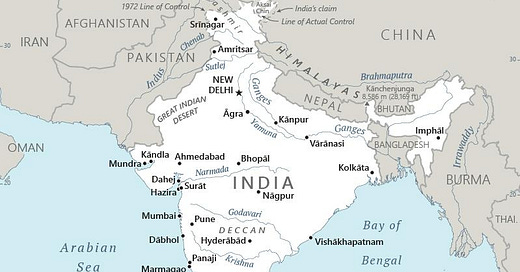


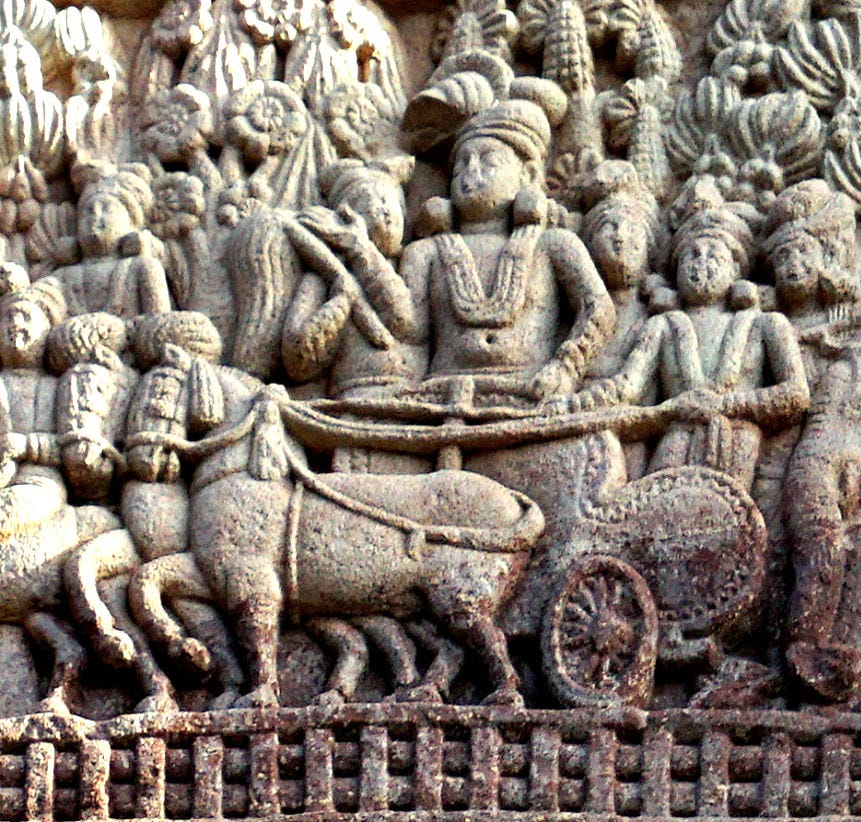



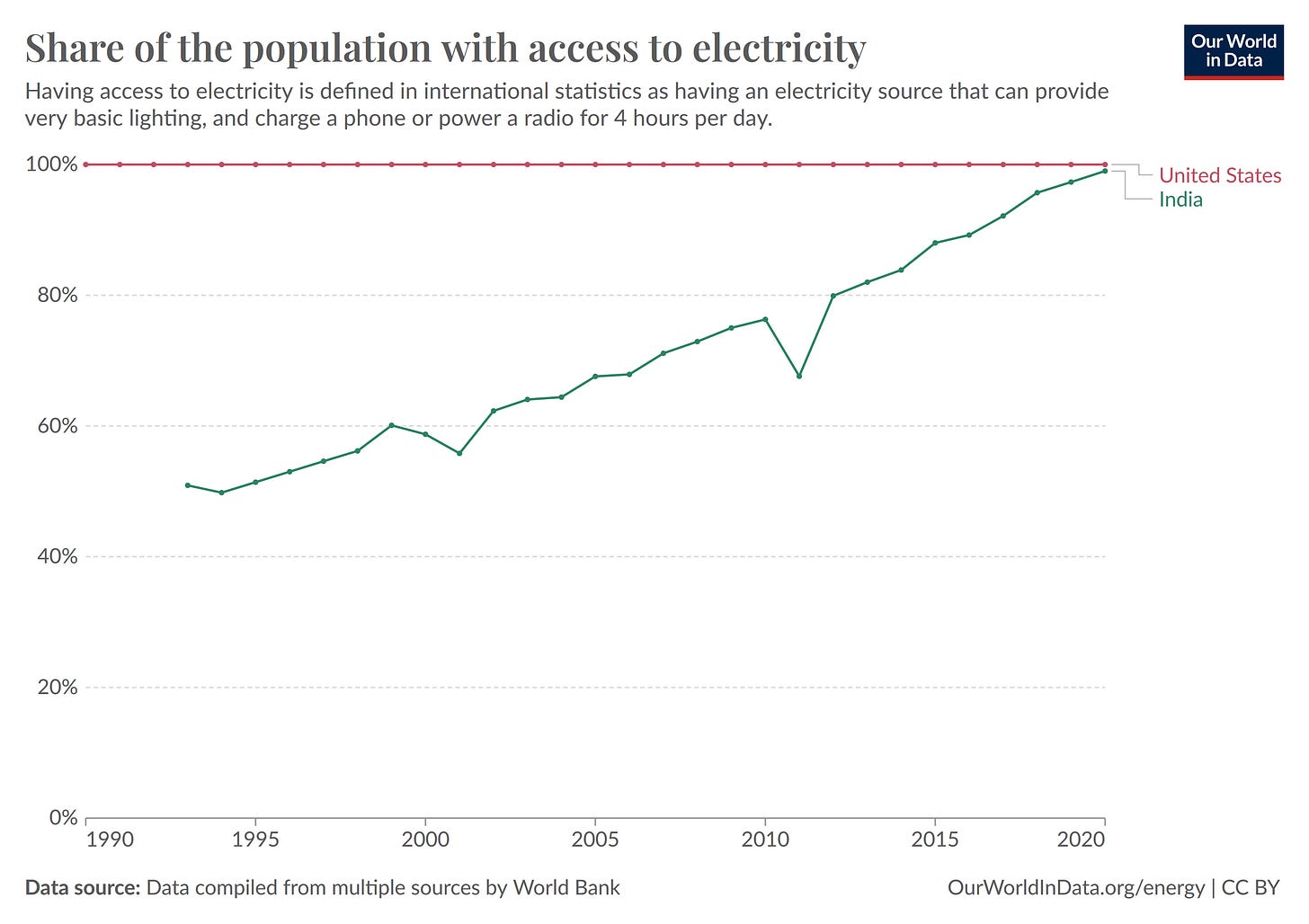


The older I get, the more I find I need to learn. I had heard of Ashoka but had no idea of the history or background. Thanks for a great article.
I read about this anomaly of history through the work of Amartya Sen and found it fascinating. So glad you're giving some air to the story for us in the West.
I don't think we can divorce Ashoka's transformation from the Buddhist religion in which he find a new worldview and that started to gain ascendancy at that time. Somewhat like Christianity, this was a religion which represented a radical break from the beliefs and philosophies of that time. Rejecting extremism and espousing skepticism, it brought into the fold the untouchables and promoted a very practical and caring approach to life. Some of the best Buddhist philosophy will come out of this changed landscape in the centuries to follow, not least of which is the skeptical Madhyamaka school which is a gold mine for thinkers today.
Dharma or dhamma can also be loosely translated as a way of life.